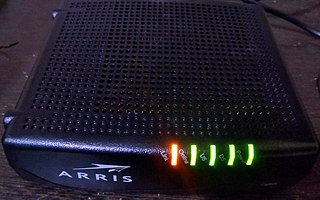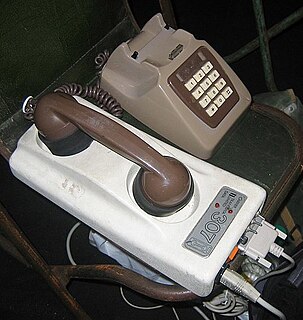
Cable television is a system of delivering television programming to consumers via radio frequency (RF) signals transmitted through coaxial cables, or in more recent systems, light pulses through fibre-optic cables. This contrasts with broadcast television, in which the television signal is transmitted over the air by radio waves and received by a television antenna attached to the television; or satellite television, in which the television signal is transmitted by a communications satellite orbiting the Earth and received by a satellite dish on the roof. FM radio programming, high-speed Internet, telephone services, and similar non-television services may also be provided through these cables. Analog television was standard in the 20th century, but since the 2000s, cable systems have been upgraded to digital cable operation.
In the evolution of modern telecommunications systems there was a requirement to connect large numbers of low-speed access devices with large telephone company 'central office' switches over common paths. During the first generations of digital networks, analog signals were digitized on line cards attached to the telephone exchange switches. In an effort to reduce local loop costs, it was decided to push this conversion closer to the customer premises by deploying small conversion devices in customer neighborhoods. These devices would combine multiple digital signals on a single link to a larger telephone switch, which would provide service to the customer. These devices were initially called remote concentrators or simply remotes.

A data circuit-terminating equipment (DCE) is a device that sits between the data terminal equipment (DTE) and a data transmission circuit. It is also called data communication(s) equipment and data carrier equipment. Usually, the DTE device is the terminal, and the DCE is a modem.
Digital subscriber line is a family of technologies that are used to transmit digital data over telephone lines. In telecommunications marketing, the term DSL is widely understood to mean asymmetric digital subscriber line (ADSL), the most commonly installed DSL technology, for Internet access.

A cable modem is a type of network bridge that provides bi-directional data communication via radio frequency channels on a hybrid fibre-coaxial (HFC), radio frequency over glass (RFoG) and coaxial cable infrastructure. Cable modems are primarily used to deliver broadband Internet access in the form of cable Internet, taking advantage of the high bandwidth of a HFC and RFoG network. They are commonly deployed in the Americas, Asia, Australia, and Europe.

Data terminal equipment (DTE) is an end instrument that converts user information into signals or reconverts received signals. These can also be called tail circuits. A DTE device communicates with the data circuit-terminating equipment (DCE). The DTE/DCE classification was introduced by IBM.

In computing, a serial port is a serial communication interface through which information transfers in or out sequentially one bit at a time. This is in contrast to a parallel port which communicates multiple bits simultaneously in parallel. Throughout most of the history of personal computers, data was transferred through serial ports to devices such as modems, terminals, and various peripherals.
Loopback, or loop-back, refers to the routing of electronic signals, digital data streams, or flows of items back to their source without intentional processing or modification. This is primarily a means of testing the communications infrastructure.
A satellite modem or satmodem is a modem used to establish data transfers using a communications satellite as a relay. A satellite modem's main function is to transform an input bitstream to a radio signal and vice versa.

A digital subscriber line access multiplexer is a network device, often located in telephone exchanges, that connects multiple customer digital subscriber line (DSL) interfaces to a high-speed digital communications channel using multiplexing techniques.
Data Over Cable Service Interface Specification is an international telecommunications standard that permits the addition of high-bandwidth data transfer to an existing cable television (CATV) system. It is used by many cable television operators to provide Internet access over their existing hybrid fiber-coaxial (HFC) infrastructure. The version numbers are sometimes prefixed with simply "D" instead of "DOCSIS".
A wireless gateway routes packets from a wireless LAN to another network, wired or wireless WAN. It may be implemented as software or hardware or a combination of both. Wireless gateways combine the functions of a wireless access point, a router, and often provide firewall functions as well. They provide network address translation (NAT) functionality, so multiple users can use the internet with a single public IP. It also acts like a dynamic host configuration protocol (DHCP) to assign IPs automatically to devices connected to the network.
A softswitch is a call switching node in a telecommunications network, based not on the specialized switching hardware of the traditional telephone exchange, but implemented in software running on a general-purpose computing platform. Like its traditional counterparts it connects telephone calls between subscribers or other switching systems across a telecommunication network. Often a softswitch is implemented to switch calls using voice over IP (VoIP) technologies, but hybrid systems exist.

A cable modem termination system or CMTS is a piece of equipment, typically located in a cable company's headend or hubsite, which is used to provide high speed data services, such as cable Internet or Voice over Internet Protocol, to cable subscribers. A CMTS provides many of the same functions provided by the DSLAM in a DSL system.

A digital subscriber line (DSL) modem is a device used to connect a computer or router to a telephone line which provides the digital subscriber line service for connection to the Internet, which is often called DSL broadband.

A DSL filter is an analog low-pass filter installed between analog devices and a plain old telephone service (POTS) line. The DSL filter prevents interference between such devices and a digital subscriber line (DSL) service connected to the same line. Without DSL filters, signals or echoes from analog devices at the top of their frequency range can reduce performance and create connection problems with DSL service, while those from the DSL service at the bottom of its range can cause line noise and other problems for analog devices.

A home network or home area network (HAN) is a type of computer network that facilitates communication among devices within the close vicinity of a home. Devices capable of participating in this network, for example, smart devices such as network printers and handheld mobile computers, often gain enhanced emergent capabilities through their ability to interact. These additional capabilities can be used to increase the quality of life inside the home in a variety of ways, such as automation of repetitive tasks, increased personal productivity, enhanced home security, and easier access to entertainment.
A residential gateway is a small consumer-grade router which provides network access between local area network (LAN) hosts to a wide area network (WAN) via a modem. The modem may or may not be integrated into the hardware of the residential gateway. The WAN is a larger computer network, generally operated by an Internet service provider.

A modem – a portmanteau of "modulator-demodulator" – is a hardware device that converts data into a format suitable for a transmission medium so that it can be transmitted from one computer to another. A modem modulates one or more carrier wave signals to encode digital information for transmission and demodulates signals to decode the transmitted information. The goal is to produce a signal that can be transmitted easily and decoded reliably to reproduce the original digital data. Modems can be used with almost any means of transmitting analog signals from light-emitting diodes to radio. A common type of modem is one that turns the digital data of a computer into modulated electrical signal for transmission over telephone lines and demodulated by another modem at the receiver side to recover the digital data.

A mobile broadband modem is a type of modem that allows a personal computer or a router to receive Internet access via a mobile broadband connection instead of using telephone or cable television lines. A mobile Internet user can connect using a wireless modem to a wireless Internet Service Provider (ISP) to get Internet access.











